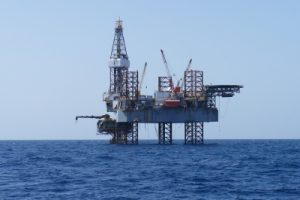The environmental impact of “fracking” has been the subject of some debate in recent years. It is the process of pumping water and some other agents into oil wells under pressure in an effort to open cracks in the rock and allow the oil and gas to get out. This process is largely responsible for the massive expansion in U.S. natural gas production allowing us to approach energy independence. So oil companies are very protective of the technology. Environmentalists on the other hand have ascribed everything from water pollution, drought and earthquakes to the process. In today’s article, we will look at a new wrinkle to the fracking debate relating to off-shore fracking. ~Tim McMahon, editor.
Offshore Fracking
The U.S. Environmental Protection Agency (EPA) published a rule on January 9, 2014 requiring oil and gas companies using hydraulic fracturing off the coast of California to disclose the chemicals they discharge into the ocean. Oil and gas companies have been fracking offshore California for perhaps as long as two decades, but they largely flew under the radar until recently.

Documents published through a Freedom of Information Act request showed that federal regulators have allowed drillers to dump chemicals into the ocean without an environmental impact statement assessing the effects of doing so. This was largely unknown to California regulators and the general public. The Bureau of Safety and Environmental Enforcement – the federal regulator responsible for regulating offshore oil drilling – has issued “categorical exclusions” for fracking offshore California, essentially giving frack jobs a pass on environmental assessments. The logic is that offshore fracking has largely occurred in existing wells, locations for which companies already jumped through all the environmental hoops long ago.
Offshore fracking could be much more widespread than even federal regulators are aware. According to the Environmental Defense Center, BSEE only began to learn about the extent to which fracking was occurring offshore when pressed to respond to FOIA requests.
The industry maintains that hydraulic fracturing is safe, and BSEE officials point to the fact that fracking offshore requires only a fraction of the water needed to do the job onshore.
But offshore fracking differs from the onshore practice in at least one important way. After an onshore well is fracked, the wastewater is often re-injected into the ground for storage. However, offshore drillers often simply dump the wastewater into the ocean – although the industry claims the water is treated before entering the marine environment.
The latest EPA rule would merely require companies to report the chemicals that they are discharging into the ocean. The rule is a weak one because relies upon companies to self-report their activities.
EPA’s announcement is a new wrinkle in the story of fracking in California, which has been much more raucously debated onshore. Last year, the state passed a controversial law that introduced the first regulations on fracking. It requires companies to disclose the chemicals used in the drilling process, obtain permits, and monitor air and water quality. Environmentalists rejected the law and are calling for a full moratorium.
Governor Jerry Brown does not support a ban on fracking and insists the new law is rigorous. Despite the complex geology that could prevent California from ever living up to its oil and gas potential, the industry and many policymakers remain in favor of trying to exploit the vast oil and gas reserves in California – both on and offshore.
You might also like:
- Can Argentina Capitalize On Its Vast Shale Reserves?
- Can Saudi Arabia Prevent The Next Oil Shock?
- Oil Merger Mania
Source: This article originally appeared here and was reprinted by permission.
By. Nick Cunningham of Oilprice.com
Image courtesy of Suwatpo / FreeDigitalPhotos.net
